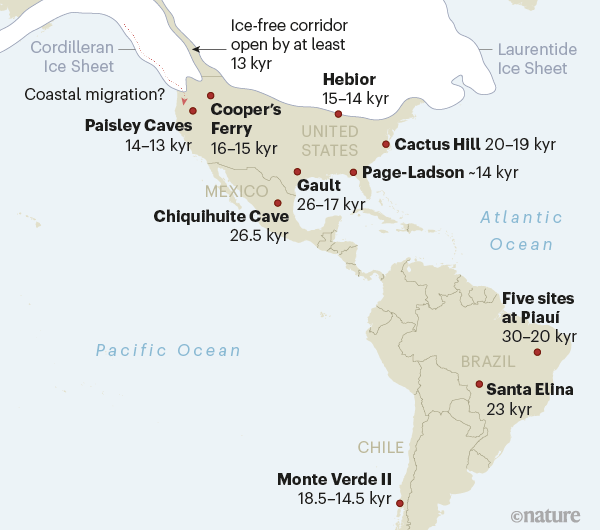Science
Related: About this forumEvidence grows that peopling of the Americas began more than 20,000 years ago
Following discoveries in the 1930s on the American Great Plains of distinctive, well-crafted stone spear points — of a type connected with the Clovis culture — alongside bones of mammoths, mastodons and a now-extinct bison species, archaeologists maintained, for many of the following decades, that the earliest people in the Americas were specialized big-game hunters who very rapidly expanded into North and South America, within 1,000 years of initial entry13. This model became known as the Clovis-first theory. It was later established that Clovis technology did not reach the southern continent. The time of their entry from Alaska into what is now the continental United States was thought to coincide with the opening of an ice-free corridor (Fig. 1) by around 13,000 years ago between the great northern continental ice sheet (called the Laurentide Ice Sheet) and the ice-covered northern Rocky Mountains (the Cordilleran Ice Sheet) in western Canada.

...
This is where the evidence from Chiquihuite Cave comes in. After an initial test excavation suggested that the site was of great antiquity, Ardelean and colleagues continued their research using a range of scientific techniques. They recovered stone artefacts of a distinctive technology located in layers with dates corresponding to around 27,000 years ago in the lowest parts of the cave’s sedimentary deposits, and the authors uncovered more artefacts in higher layers that dated to up to 13,000 years ago. The dating for the layer with the earliest artefacts indicates that there were people in northern Mexico at a time corresponding to the beginning of, or early during, the last major stage of glacial advance in North America.
Ardelean and colleagues’ suggestion that the initial entry date was as far back as 33,000 years ago, which is more than double the currently popular date of around 16,000 years ago, will be very hard for most archaeologists specializing in early America to accept. There will undoubtedly be challenges to this interpretation and close examination of the site data. The six Brazilian archaeological sites dated as older than 20,000 years ago, five in the centre of the state of Piauí6–11 and one in central Mato Grosso (the Santa Elina rock shelter)12, although expertly excavated and analysed, are commonly disputed or simply ignored by most archaeologists as being much too old to be real. The findings at Chiquihuite Cave will bring about fresh consideration of this issue.
https://www.nature.com/articles/d41586-020-02137-3
The paper: https://www.nature.com/articles/s41586-020-2509-0
PoindexterOglethorpe
(25,853 posts)about the subject of when the first humans arrived here. One person interviewed said that the assumption that humans arrived about 13,000 years ago, based on the Clovis spearpoints, was so strongly entrenched that archeologists simply didn't bother to excavate below that time. That same person talked about firm evidence that humans had arrived in southern South America thousands of years before was simply ignored by the establishment.
Sometimes science is blind and deaf.
Warpy
(111,255 posts)They found bones and rock art in eastern Brazil that were originally assumed to be African, just from the skull features that were still intact. When they ran the genome, they were shocked to find out they'd come by way of Melanesia or Australia. Island hopping during the glacial maximum was probably a lot easier, much more land was exposed.
I'm not a bit surprised there were alternate routes here. Boats made of skins are surprisingly seaworthy and hunting cultures could have lived aboard them for a long time. Another giveaway is the cluster of people with Denisovan DNA they found in northern Peru and southern Ecuador. It's fascinating trying to trace deep time migration patterns through DNA oddities. We're probably the last people who will be able to do this if civilization and global travel hang together.
I'm always amazed by the power of conventional thinking. They've known about a lot of these sites for decades, but it's only in the last 10 years or so that I've seen them taken at all seriously.
Judi Lynn
(160,527 posts)hunter
(38,311 posts)This started more than 40,000 years ago.
Evidence of coastal settlements were lost as the ice melted and the oceans rose.
Walking and sailing long distances, living off the various resources of the land and sea, is what humans do.
There was a tendency of white racist anthropologists to dismiss the technical achievements of everyone else. They'd rather believe people they regarded as "primitives" simply shuffled along very, very slowly.
All the stories of European "discovery" and conquest, the stories taught to so many U.S. schoolchildren, are shameful.